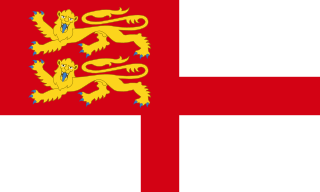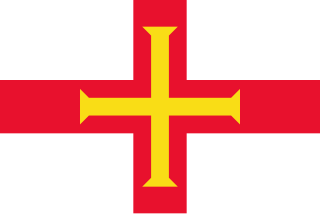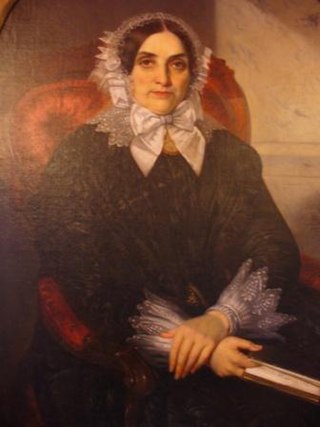
The Channel Islands are an archipelago in the English Channel, off the French coast of Normandy. They are divided into two Crown Dependencies: the Bailiwick of Jersey, which is the largest of the islands; and the Bailiwick of Guernsey, consisting of Guernsey, Alderney, Sark, Herm and some smaller islands. Historically, they are the remnants of the Duchy of Normandy. Although they are not part of the United Kingdom, the UK is responsible for the defence and international relations of the islands as it is for the other Crown Dependency, the Isle of Man, and the British Overseas Territories. The Crown Dependencies are neither members of the Commonwealth of Nations, nor part of the European Union. They have a total population of about 171,916, and the bailiwicks' capitals, Saint Helier and Saint Peter Port, have populations of 33,500 and 18,207 respectively.

Sark is an island, part of the Channel Islands in the southwestern English Channel, off the coast of Normandy, France. It is a royal fief, which forms part of the Bailiwick of Guernsey, with its own set of laws based on Norman law and its own parliament. It has a population of about 500. Sark has an area of 2.10 square miles (5.44 km2). Little Sark is a peninsula joined by a natural but high and very narrow isthmus to the rest of Sark Island.

The Seigneur of Sark is the head of Sark in the Channel Islands. "Seigneur" is the French word for "lord", and a female head of Sark is called Dame of Sark, of which there have been three. The husband of a female ruler of Sark is not a consort but is jure uxoris a seigneur himself.

Seigneur John Michael Beaumont was the twenty-second Seigneur of Sark in the Channel Islands. He worked as a civil engineer before succeeding his paternal grandmother, Sibyl Hathaway, the 21st Dame of Sark, in 1974. During his rule, Beaumont saw the loss of many feudal rights enjoyed by the seigneurs, and he was consequently often described as the "last feudal baron".

Dame Sibyl Mary Hathaway was Dame of Sark from 1927 until her death in 1974. Her 47-year rule over Sark, in the Channel Islands, spanned the reigns of four monarchs: George V, Edward VIII, George VI and Elizabeth II.
William Frederick Collings was seigneur of Sark from 1882 until his death. One of the most eccentric lords of the island, he was known for his anti-clericalism, stubbornness, intemperance and generosity.
Marie Collings, sometimes referred to as Mary Collings, was a wealthy Guernsey heiress who ruled as Dame of Sark (island) from 1852 to 1853, being the island's second female ruler and the first holder of the fief from the presently ruling seigneurial family. She inherited the fortune of her father, the privateer John Allaire, who had obtained the mortgage on the fief shortly before his death. The island's then-ruling seigneur, Pierre Carey le Pelley, soon had no option but to sell the fief to Collings, but she never actively governed it.

Brecqhou is one of the Channel Islands, located off the west coast of Sark where they are now geographically detached from each other. Brecqhou is politically part of both Sark and the Bailiwick of Guernsey. It has been established in the courts that Brecqhou is a tenement of Sark. The Ministry of Justice, the department of the United Kingdom government with responsibility for the Channel Islands, considers Brecqhou part of Sark.
The Crown Dependencies are three offshore island territories in the British Islands that are self-governing possessions of the British Crown: the Bailiwick of Guernsey and the Bailiwick of Jersey, both located in the English Channel and together known as the Channel Islands, and the Isle of Man in the Irish Sea between Great Britain and Ireland.

The Bailiwick of Guernsey is a self-governing British Crown Dependency off the coast of Normandy, France, comprising several of the Channel Islands. It has a total land area of 78 square kilometres (30 sq mi) and an estimated total population of 67,334.
A bailiwick is usually the area of jurisdiction of a bailiff, and once also applied to territories in which a privately appointed bailiff exercised the sheriff's functions under a royal or imperial writ.

The lieutenant governor of Guernsey is the representative of the British monarch in the Bailiwick of Guernsey, a Crown dependency of the British Crown. The role of the lieutenant governor is to act as the de facto head of state in Guernsey and as liaison between the governments of Guernsey and the United Kingdom. The holder of this office is also ex officio a member of the States of Guernsey but may not vote and, by convention, speaks in the Chamber only on appointment and on departure from post. The duties are primarily diplomatic and ceremonial. He has the authority to appointment two members of the board of governors of Elizabeth College and the Priaulx Library.

The coat of arms of Guernsey is the official symbol of the Channel Island of Guernsey. It is very similar to the arms of Normandy, Jersey, and England.

The following outline is provided as an overview of and topical guide to Guernsey:
Francis William Lionel Collings Beaumont, also known as F. W. L. C. Beaumont or “Buster" Beaumont, was the heir to the Seigneur of Sark, a Royal Air Force officer, film producer and the husband of actress Mary Lawson. He and Lawson were killed in 1941 during the Liverpool Blitz.

Seigneur or lord is an originally feudal title in France before the Revolution, in New France and British North America until 1854, and in the Channel Islands to this day. The seigneur owned a seigneurie, seigneury, or lordship—a form of title or land tenure—as a fief, with its associated obligations and rights over person and property. In this sense, a seigneur could be an individual—male or female, high or low-born—or a collective entity, typically a religious community such as a monastery, seminary, college, or parish. In the wake of the French Revolution, seigneurialism was repealed in France on 4 August 1789 and in the Province of Canada on 18 December 1854. Since then, the feudal title has only been applicable in the Channel Islands and for sovereign princes by their families.

The Courts of Guernsey are responsible for the administration of justice in the Bailiwick of Guernsey, one of the Channel Islands. They apply the law of the Island, which is a mixture of customary law dating back as far as the 10th century and legislation passed by the legislature, the States of Deliberation.

The island of Sark forms part of the Bailiwick of Guernsey which with the Bailiwick of Jersey form the Channel Islands. Offered the opportunity to evacuate the island in June 1940, most locally born islanders decided to stay. The 470 civilians who remained on the island would be subject to German rule for the next five years, until Sark was liberated on 10 May 1945. The main contact between the Sark residents and the German authorities in 1940 was 56-year old Sibyl Hathaway, who was Dame of Sark from 1927 until her death in 1974.
From the Middle Ages, the Channel Islands were administered according to a feudal system. Alongside the parishes of Jersey and Guernsey, the fief provided a basic framework for rural life; the system began with the Norman system and largely remained similar to it. Feudalism has retained a more prominent role in the Channel Islands than in the UK. The Channel Islands are remnants of the Duchy of Normandy and are held directly by the crown on a feudal basis as they are self-governing possessions of the British Crown. This peculiarity underscores the deep-seated influence of feudalism in the Channel Islands; their allegiance isn't so much to England but rather directly to the monarch.
















